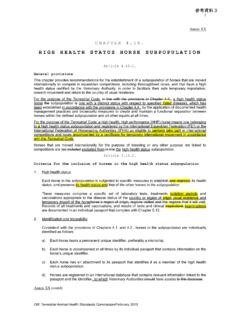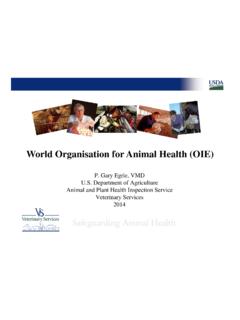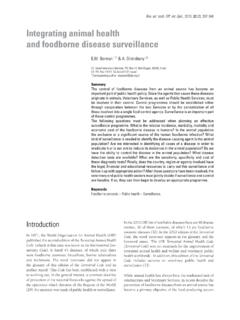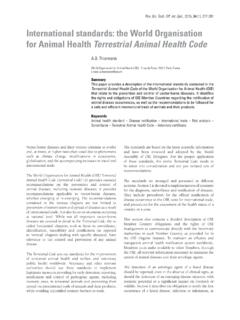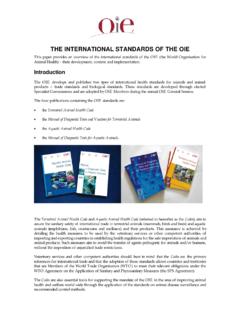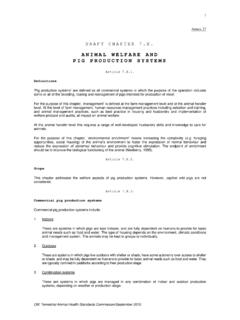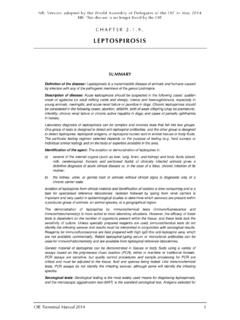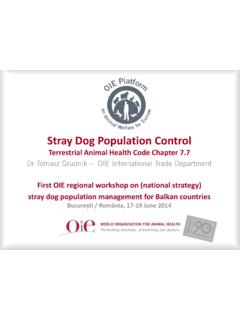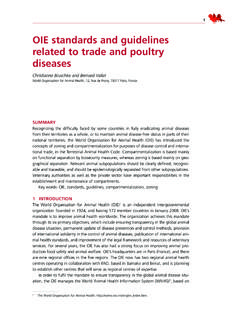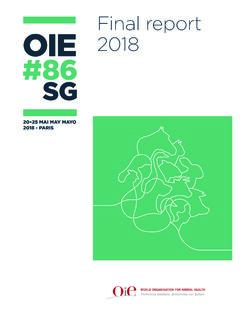Transcription of The role of the World Organisation for Animal Health (OIE ...
1 727 2008, Japanese Society for Alternatives to Animal ExperimentsThe role of the World Organisation for Animal Health (OIE) in the development of international standards for laboratory Animal welfareSarah KahnHead, International Trade Department, World Organisation for Animal Health (OIE)12 rue de Prony 75017 Paris, FrancePhone: +(33)-144151888, World Organization for Animal Health (OIE) is a Paris-based inter-governmental body formed in 1924 with the objective of improving transparency and international collaboration in the control of serious epizootic Animal diseases. At the time of publication the OIE has 170 formation in 1995 of the World Trade Organisation (WTO) saw the recognition of the OIE as the reference international normative organization for Animal Health and zoonotic diseases.
2 In 2001 the OIE Member Countries agreed to expand the OIE's historical mandate to include Animal welfare. The publication in 2005 of OIE standards for the transport, slaughter and killing of livestock for the purpose of disease control was a benchmark in the development of international Animal welfare norms. As for all OIE standards, the Guidelines are based on science and take full account of the differing ethical, cultural, religious and political contexts of OIE Permanent Animal Welfare Working Group (PAWWG), supported by expert groups convened to address specific subjects, develops the basic scientific texts.
3 Members of groups are selected for their knowledge and experience and to be broadly representative of the five OIE regions. They do not speak for particular countries or organizations; rather they present scientific information. In addition to its collaboration with national Veterinary Services, the OIE draws upon non-governmental organisations (NGOs), including academia, the research community, industry and Animal welfare Members asked the OIE to develop standards for laboratory Animal welfare in 2005. Since this time the OIE has held meetings with representatives of the International Council for Laboratory Animal Science (ICLAS) and allied organizations and is developing a framework for collaboration with experts in laboratory Animal science.
4 This paper presents the OIE Guiding Principles for Animal Welfare and important considerations in regard to standard setting for laboratory Animal welfare. Keywords: OIE, ICLAS, international harmonisationIntroductionThe World Organization for Animal Health (OIE) is a Paris-based inter-governmental body that has the objective of improving transparency and international collaboration in the control of serious epizootic Animal diseases. The OIE is responsible for setting international Animal Health and welfare standards, which cover, inter alia, disease diagnosis, reporting and management, Health measures for international trade in animals and Animal products, and standards for the humane transport and slaughter of animals.
5 The paper describes the mission, operating procedures and work program of the OIE in Animal welfare with a focus on the work of the OIE in establishing international standards for the welfare of laboratory animals. OIE background The OIE is an inter-governmental Organisation created in 1924 in an effort to control Animal diseases in Europe. The countries recognised the need to work together to prevent the spread of serious Animal diseases that are not limited by international borders. Older than the United Nations (UN), the OIE remains outside the UN family but works in close collaboration with UN organisations, especially the Food and Agriculture Organization (FAO) and the World Health Organisation (WHO), that share some of the OIE's OIE mandate still emphasises prevention of the global spread of diseases, particularly trans-boundary diseases, but the mandate and mission of the OIE have broadened considerably.
6 Animal welfare AATEX 14, Special Issue, 727-730 Proc. 6th World Congress on Alternatives & Animal Use in the Life SciencesAugust 21-25, 2007, Tokyo, Japan728 Sarah Kahnhas been identified as a strategic priority since 2001. The OIE took steps to raise awareness of its Animal welfare standard setting work in 2004 with a Global Conference on Animal Welfare (see published proceedings at: OIE Strategic Plan 2006-2010 identifies the OIE mandate as 'the improvement of Animal Health globally'; the global fight against poverty is one of the main drivers of OIE activities. The OIE aims to help alleviate poverty through the following activities: improving public Health by fighting zoonotic diseases; improving the sanitary safety of international trade; facilitating access to regional and international markets; encouraging national Veterinary Services to apply the rules established by the OIE for safe trade; and promoting Animal welfare through Animal Health and the adoption of international the time of writing, the OIE has 170 Members grouped in five regions, with 29 countries in the Americas; 51 in Africa, 50 in Europe, 13 in the Middle East and 27 in Asia and Oceania.)
7 The OIE International Standards relevant to terrestrial Animal Health and welfare are presented in the terrestrial Animal Health Code (the Code), which is updated at the OIE General Session held annually in May. Texts are drafted by expert groups for potential inclusion in the Code and are officially adopted by the Delegates, meeting in plenary as the International Committee at the OIE General Session. This procedure is the sole pathway for the establishment of OIE standards (see Fig. 1). As the normative publication on standards for international trade in animals and their products, the terrestrial Code has legal force for World Trade Organisation (WTO) Member countries.
8 Animal welfare guidelines are not covered by the WTO Agreement dealing with Health (sanitary) standards but their inclusion in the terrestrial Code provides an international benchmark for OIE Members and many OIE Members use them as references in negotiating bilateral and multilateral agreements on international Fig. 1. The OIE Standard-Setting Procedure729trade. The Animal welfare work program of the OIE is coordinated by the Permanent Animal Welfare Working Group (PAWWG), whose mission statement is "To provide international leadership in Animal welfare through the development of science-based standards and guidelines, provision of expert advice and the promotion of relevant education and research.
9 " Members of the PAWWG are selected for their expertise and to be broadly representative of the five OIE regions. Members are drawn from government, academia, international non-governmental organisations (NGOs) and international industry organizations. To date, the industry members and observers in the PAWWG are from organisations dealing with farm animals rather than laboratory animals. Under the auspices of the PAWWG, ad hoc Groups are convened to develop texts on specific topics as the basis for OIE standards. Members are drawn from government, academia, government and the private sector, including organisations that have a formal agreement with the OIE.
10 In addition to several industry organisations, the OIE has or is developing formal agreements with the World Society for the Protection of Animals (WSPA), the International Council for Laboratory Animal Science (ICLAS) and the International Federation for Animal Health (IFAH), all of which are organisations that take a keen interest in laboratory animals. The proposed OIE/ICLAS Agreement is of particular relevance to laboratory Animal welfare. The text of the agreement notes the common interests of the two organisations and recognises the benefit of cooperation in the development and revision of international Animal welfare standards and guidelines.

